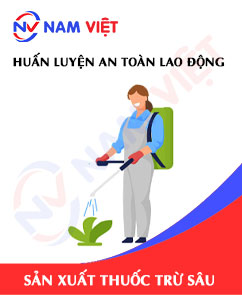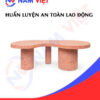Occupational Safety Training for Pesticide Manufacturing
99,000 ₫
Note: The above price is calculated for one person, and the price may fluctuate depending on the number of trainees participating in the course and market movements. For more accurate pricing support, please refer to the pricing table or contact our consulting staff directly.
Occupational safety is an important issue in factories manufacturing pesticides and must be addressed promptly to ensure the health and safety of workers while enhancing the reputation of businesses. The Occupational Safety Training course is one of the effective solutions to increase awareness of how to prevent workplace accidents for workers involved in pesticide manufacturing.
Table of Contents
Toggle1. Overview of Pesticides
a. What are pesticides?
Pesticides are substances used to kill and control pests that harm crops, plants, or livestock. Pesticides can be applied by spraying, irrigation, or misting and can be used on soil, plant leaves, or fruits.
Pesticides can be manufactured from synthetic chemicals or natural substances such as plant essential oils. However, using pesticides requires caution to avoid negative impacts on the environment and human health.

b. Machinery used in pesticide manufacturing
The types of machinery used in pesticide manufacturing usually include:
- Pesticide mixing machines: These machines are used to mix and blend chemical compounds to produce pesticides. Pesticide mixing machines can be adjusted to produce different types of pesticides.
- Pesticide spraying machines: These machines are used to spray pesticides on crops, plants, or livestock. They can be designed for manual use or mounted on vehicles.
- Pesticide irrigation machines: These machines are used to irrigate pesticides onto soil or plants. They can be designed for manual use or installed on irrigation equipment.
- Pesticide drying machines: These machines are used to dry pesticides after manufacturing and mixing with other components.
- Pesticide packaging machines: These machines are used to package pesticides into bags or bottles to ensure product stability and ease of use.

c. Pesticide manufacturing companies in Vietnam
There are many pesticide manufacturing companies in Vietnam, including major and well-known ones such as:
- Vietnam Plant Protection Joint Stock Company (VACO): VACO is one of the leading pesticide manufacturers in Vietnam. Established in 1959, it has grown to become a leading unit in plant protection.
- Vietnam Chemicals Joint Stock Company (Vinachem): Vinachem manufactures and trades chemical products, including pesticides. Founded in 1996, it is now one of Vietnam’s leading chemical companies.
- IMEXPHARM Pharmaceutical Company Limited: Established in 1977 and headquartered in Ho Chi Minh City, IMEXPHARM manufactures pesticides widely used in the Vietnamese market.
- Ha Tay Pharmaceutical Manufacturing and Trading Company Limited: Founded in 1976 and headquartered in Hanoi, the company specializes in pharmaceutical products, including pesticides, widely used in Vietnam.

d. Specific jobs in a pesticide manufacturing factory
Group 1
- Chief Executive Officer, Deputy CEO, Department Heads in the pesticide manufacturing factory.
Group 2
- Safety officers: manage safety in the factory, design safety procedures, supervise and ensure employees follow safe working processes.
Group 3
- Production and packaging: Factories have production lines to manufacture ingredients, mixtures, and final products. These products are then packaged and prepared for shipment.
- Quality control: Factories may have quality control departments to ensure products meet safety and industry standards.
- Transportation and storage: After manufacturing and packaging, products are transported to sales points or distributors. Factories may also have warehouses to store pesticides under appropriate conditions to maintain quality.
- Equipment maintenance and repair: Staff must maintain and repair equipment to ensure efficient production and employee safety.
Group 4
- Office work, service, sales, marketing.
- Production management, quality management, human resources management, material management, financial and accounting management.
- Research and development: Factories may have R&D departments to discover new ingredients or develop formulas for new pesticides.

2. Overview of occupational safety training for pesticide manufacturing
This article focuses on issues related to Group 3 because Group 3 directly participates in manufacturing and faces the highest occupational safety risks. Refer to other groups here.
a. What is Group 3 occupational safety training?
- Group 3 occupational safety training consists of sessions that equip workers with awareness and methods to prevent workplace accidents.
- The training course helps workers identify and avoid hazards, reducing the risk of workplace accidents.
REGISTER FOR OCCUPATIONAL SAFETY TRAINING SERVICE
b. Training duration
Initial occupational safety training
- Total training hours is at least 24 hours, including assessment time.
- 8 hours of theory on occupational safety policies and regulations
- 8 hours of theory on basic occupational safety knowledge
- 4 hours of theory on specialized training content
- 2 hours of practical exercises on specialized training content
- 2 hours of theoretical assessment at the end of the course
The occupational safety training center will arrange multiple sessions depending on employee schedules. Typically, there are 6 sessions over 3 days, provided the manufacturing company arranges continuous learning time.
Periodic occupational safety training
- Before the occupational safety card expires, employees seeking renewal must undergo periodic occupational safety training, with training duration at least 50% of the initial training time.
Explanation: The total periodic occupational safety training time is at least 12 hours, including assessment. After completing the course and passing the test, employees will receive a renewed occupational safety card.
c. Training content
| No. | TRAINING CONTENT | TRAINING HOURS | |||
| Total | Including | ||||
| Theory | Practice | Assessment | |||
| I | Occupational safety policies and regulations | 8 | 8 | 0 | 0 |
| 1 | Overview of legal documents and regulations on occupational safety. | 6 | 6 | ||
| 2 | Standards and technical regulations on occupational safety. | 1 | 1 | ||
| 3 | Specific regulations by state management agencies regarding occupational safety when constructing, expanding, or renovating manufacturing facilities, using, storing, and inspecting machines, equipment, materials, or hazardous substances. | 1 | 1 | ||
| II | Basic knowledge on occupational safety | 8 | 8 | 0 | 0 |
| 1 | Basic knowledge of workplace hazards and harmful factors. | 4 | 4 | ||
| 2 | Methods to improve working conditions. | 1 | 1 | ||
| 3 | Safety culture in manufacturing and business. | 1 | 1 | ||
| 4 | Rights and responsibilities of employers and employees; policies on occupational safety; roles of safety network personnel. | 1 | 1 | ||
| 5 | Safety rules, signs, instructions, use of safety equipment, personal protective equipment; first aid skills for workplace accidents, prevention of occupational diseases. | 1 | 1 | ||
| III | Specialized training content | 6 | 4 | 2 | 0 |
| Comprehensive knowledge of machines, equipment, substances generating hazards; risk analysis, occupational safety management, and safe working procedures with equipment and hazardous substances. | 6 | 4 | 2 | ||
| IV | End-of-course assessment | 2 | 2 | 0 | 0 |
| Total | 24 | 22 | 2 | ||
See also training content for all 6 groups
d. Occupational safety card
After completing occupational safety training and passing the assessment, employees will receive a Group 3 occupational safety card (commonly referred to as Group 3 occupational safety certificate).
The card shows information such as: full name, date of birth, job, and specific work environment. It also shows training duration, official stamp, and signature confirming course completion.
According to regulations in Clause 2 of Article 24 of Decree 44/2016/ND-CP, there are two cases:
- If the employer and employee have a labor contract, the employer must stamp and sign the Group 3 safety card after the employee completes training at an occupational safety training unit and passes the assessment.
- If the employee is freelance or seasonal, without a labor contract, the training unit must stamp and sign the safety card after training completion and assessment.

3. Identifying Hazards Affecting Workers in Pesticide Manufacturing
Pesticide manufacturing is a high-risk job for workers’ health, so it is essential to recognize hazards that may affect their well-being. Some common hazards in pesticide manufacturing include:
- Risk of exposure to toxic chemicals: Chemicals used in pesticide manufacturing can cause harmful health effects for workers such as headaches, dizziness, difficulty breathing, or severe poisoning.
- Risk of explosion and fire: Chemicals used in pesticide manufacturing can cause explosions or fires if not handled properly. This can impact the health of workers and surrounding areas.
- Risk from toxic emissions: Pesticide manufacturing also generates hazardous emissions, including toxic fumes and fine dust. Exposure can lead to health issues such as pneumonia, bronchitis, and eye or skin problems.
- Risk of collisions and accidents: Working with machinery and equipment in pesticide manufacturing factories may lead to accidents such as collisions, cuts, or other occupational safety issues.
- Electrical hazards: If electrical equipment in the factory is not maintained regularly, lacks insulation, or is not waterproofed, it poses a risk of electric shock during manufacturing.
4. Common Workplace Accidents in Pesticide Manufacturing
Common workplace accidents in pesticide manufacturing include:
- Chemical effects: Risk of burns or injuries from direct contact with chemicals, inhaling fumes, or ingestion. Symptoms may include red skin, itching, rash, difficulty breathing, headaches, fatigue, or nausea.
- Equipment accidents: Risk of injury when operating machinery, production tools, or electrical devices.
- Airbags: Risk of explosion if not handled properly.
- Fire and explosion: Risk of fire or explosion if chemicals are not stored or transported correctly.
- Emergency evacuation: Risk of emergencies including fire, explosion, or chemical spills. Workers must be trained to respond quickly and safely.
- Risk of poisoning: Long-term exposure to chemicals in pesticide manufacturing can cause health issues such as cancer, kidney disease, liver disease, and digestive problems.

5. Safety Measures in Pesticide Manufacturing
Safety measures in pesticide manufacturing include:
- Use of protective equipment: Workers should be provided with masks, gloves, safety goggles, chemical-resistant clothing, safety shoes, helmets, etc.
- Use of safety equipment: Pesticide factories should be equipped with fire extinguishers, ventilation systems, water spray systems, and other safety devices.
- Safety knowledge and skills training: Workers should be trained on chemical types, use of protective equipment, fire and explosion prevention techniques, etc.
- Regular health checks: Workers should undergo periodic health screenings to detect early issues related to exposure to hazardous chemicals.
- Safe management and operation of manufacturing systems: Factories must manage operations strictly, follow correct procedures, and regularly inspect systems to prevent accidents.
- Ensure occupational hygiene: Factories must maintain cleanliness in manufacturing areas, personal hygiene, and general hygiene for employees.
- Minimize exposure to toxic chemicals: Use automated systems for mixing chemicals or automatic spraying equipment to reduce direct contact.
- Regular occupational environment monitoring in factories to collect and analyze harmful factors, then adjust to reduce risks and prevent occupational diseases.
6. Benefits of Occupational Safety Training in Pesticide Manufacturing
An Toan Nam Viet provides businesses with the following benefits upon completing occupational safety training courses in accordance with Decree 44/2016/NĐ – CP on occupational safety and hygiene:
- Workers can identify potential hazards and take preventive measures to avoid accidents.
- Businesses can establish risk prevention measures in manufacturing, operation, and maintenance processes.
- Minimize costs related to workplace safety risks.
- Uninterrupted manufacturing enhances productivity and product quality.
- Compliance with labor safety laws reduces legal risks.
- Enhances credibility and professionalism, improving the business brand.
Nam Viet’s training courses are designed to prevent external hazards, helping individuals avoid dangers that could result in injury or, in severe cases, death.
REGISTER FOR OCCUPATIONAL SAFETY TRAINING SERVICE
7. Customer Feedback after Completing Pesticide Manufacturing Safety Training
An Toan Nam Viet has years of experience accompanying businesses in Vietnam, especially in southern provinces. This responsibility is invaluable to Nam Viet, which is why occupational safety training is increasingly professional. Our growth is fueled by positive feedback and suggestions from businesses. Below are some testimonials from our partners.
See more customer interviews after using An Toan Nam Viet services
8. Training Capacity of An Toan Nam Viet
An Toan Nam Viet is a reputable and quality occupational safety training center in Vietnam. Training sessions are held continuously at manufacturing workshops, factories, or construction sites nationwide (all 63 provinces in Vietnam).
REGISTER FOR OCCUPATIONAL SAFETY TRAINING SERVICE
Licenses for occupational safety training
- An Toan Nam Viet has been inspected and certified by the Department of Labor Safety under the Ministry of Labor, War Invalids and Social Affairs to certify our capability in occupational safety and hygiene training.

Materials and lectures
- Training materials are carefully reviewed and approved before being used in occupational safety courses to ensure accuracy and effectiveness.
- Teaching methods are standardized according to An Toan Nam Viet protocols, developed by occupational safety experts to maximize knowledge retention.
Facilities
- Control of classroom factors enhances teaching efficiency and knowledge absorption.
- Our training facilities include spacious classrooms with standard lighting and training equipment.
9. Nationwide Reputable Occupational Safety Training Center
At An Toan Nam Viet, we prioritize occupational safety training as our core mission. We aim to equip workers with knowledge to protect themselves, contributing to national development.
We meticulously prepare every detail of training, from teaching tools and materials to sound and lighting.
Our instructors are experienced experts, with research on hazard identification and prevention across industries. Lectures are practical, engaging, and compliant with Decree 44/2016/NĐ-CP.
Our training center offers:
- Competitive training costs without compromising quality.
- Flexible training schedules according to company production needs.
- Quick and lawful certification procedures.
- Experienced instructors.
- Classroom control to enhance teaching efficiency and knowledge retention.
- Lectures tailored for occupational safety in enterprises.
- Dedicated and professional support for clients.

10. Additional Reference Materials for Pesticide Manufacturing Safety Training
- Pesticide Manufacturing Safety Training Materials
- Occupational Safety Training Materials Collection
- Occupational Safety Training Test Collection
- Pesticide Manufacturing Safety Quiz
- Pesticide Manufacturing Safety Training Slides
1 review for Occupational Safety Training for Pesticide Manufacturing
No comments yet















namchinh.haiphong341
Dịch vụ huấn luyện an toàn lao động rất tốt nhé, giảng viên dạy rất sinh động dễ hiểu!